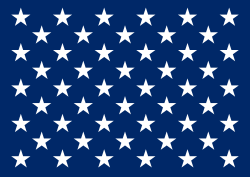United States Coast Guard

The United States Coast Guard is one of the six branches of the military of the United States and is part of the U.S. Department of Homeland Security. The Coast Guard's purpose is to protect the people, environment, industry, and security of the United States on seas, lakes, and rivers. To do so, the Coast Guard uses boats, ships, helicopters, and airplanes to stop smuggling and other crime and terrorism and to rescue ships and boats in danger.
The Coast Guard traces its roots back to the United States Revenue Cutter Service, which was created by Congress on 4 August 1790.[1] As such, the Coast Guard is the oldest continuous seagoing service of the United States.[a]
The modern United States Coast Guard was started on January 28, 1915. This is when the U. S. Congress ordered the United States Revenue Cutter Service and the United States Life-Saving Service to merge into a single service. The Coast Guard can become part of the U.S. Department of the Navy during wartime, but that is not the case now. It became part of the U.S. Department of Homeland Security in 2003.
History
The U.S. Revenue Cutter Service (USRCS) was set up in 1790 when U.S. President George Washington signed an act allowing the building of 10 boats called "cutters."[b][5] The service was first suggested in a letter by Alexander Hamilton as a way to collect tariffs that were being lost to smuggling.[c][7] It also had the task of making sure that shipments of goods from the United States got through to markets in other countries.[7] The first Coast Guard station was in Newburyport, Massachusetts. Until the re-establishment of the U.S. Navy in 1798, the Revenue Cutter Service was the only naval force of the United States.
The modern Coast Guard can be said to date to 1915, when the Revenue Cutter Service merged with the U.S. Life-Saving Service,[8] when Congress formalized the existence of the new organization. In 1939, the Lighthouse Service was brought under the Coast Guard's purview. In 1942, the Bureau of Marine Inspection and Navigation was transferred to the Coast Guard.[9][10] In 1967, the Coast Guard moved from the U.S. Department of the Treasury to the newly-formed U.S. Department of Transportation, an arrangement that lasted until it was placed under the U.S. Department of Homeland Security in 2003 as part of legislation that was designed to protect American interests more efficiently after the terrorist attacks of 11 September 2001.
In wartime, the Coast Guard or individual components of it can operate as a service of the U.S. Department of the Navy. That arrangement has a broad historical basis, as the Coast Guard has been involved in wars as diverse as the War of 1812, the Mexican–American War, and the American Civil War, the last of which had the cutter Harriet Lane fire the first naval shots attempting to relieve the besieged Fort Sumter. The last time that the Coast Guard operated as a whole within the Navy was during World War II. Military and combat units of the Coast Guard more often operate under Navy or joint operational control, with other Coast Guard units remaining under the Department of Homeland Security.
United States Coast Guard Media
A USCG HH-65 Dolphin helicopter flies overhead as the Coast Guard Cutter Resolute steams near Deepwater Horizon spill site, July 4, 2010.
USCG helicopter, Rescue swimmers conduct search and rescue after Hurricane Irma
USCG Munro Law Enforcement Detachments boarding team interdicts suspected drug smuggling vessel
USCGC patrol boat forces North Vietnamese trawler aground after combat from direct fire (Vietnam War)
Notes
- ↑ Although the U.S. Navy lists its founding as 1775 with the formation of the Continental Navy, that service was disbanded with the last of its ships being sold in 1785.[2] The modern U.S. Navy in its present form was founded by an Act of Congress in March 1794 which authorized a naval fleet of six ships.[3]
- ↑ The term cutter came from the boats used by Great Britain's Royal Customs Service.[4] Modern Coast Guard cutters are larger ships, regardless of their type.[4]
- ↑ After the American Revolutionary War, the United States was struggling financially. The new country depended on the money that it received from import tariffs. Smuggling had been seen as a patriotic duty during the war but was now robbing the country of one of its major sources of revenue.[6]
References
- ↑ "04 Aug U.S. Coast Guard Celebrates 225th Anniversary". Sun News. Sun Broadcast Group. Retrieved 22 October 2016.[dead link]
- ↑ "The Continental Navy". GlobalSecurity.org. Retrieved 22 October 2016.
- ↑ "Launching the New U.S. Navy". The National Archives. 15 August 2016. Retrieved 22 October 2016.
- ↑ 4.0 4.1 "Eighteenth, Nineteenth & Early Twentieth Century Revenue Cutters". United States Coast Guard, U.S. Department of Homeland Security. Retrieved 14 October 2016.
- ↑ Erin Allen (4 August 2014). "Semper Paratus, Always Ready". Library of Congress. Retrieved 13 October 2016.
- ↑ Robert Pendleton; Patrick McSherry. "The U. S. Revenue Cutter Service in the Spanish American War". The Spanish American War Centennial Website!. Retrieved 14 October 2016.
{{cite web}}: CS1 maint: multiple names: authors list (link) - ↑ 7.0 7.1 "Early Years Of The Revenue Cutter Service". US Military.com. 26 May 2008. Retrieved 13 October 2016.
- ↑ "Historic Light Stations". U.S. Coast Guard. Retrieved 21 January 2015.
- ↑ "U.S. Steamboat Inspection Service". U.S. Coast Guard. Retrieved 21 January 2015.
- ↑ Uscg vessel documentation Archived 2024-12-06 at the Wayback Machine usvesselregistrar. 2006–2007 Session.








